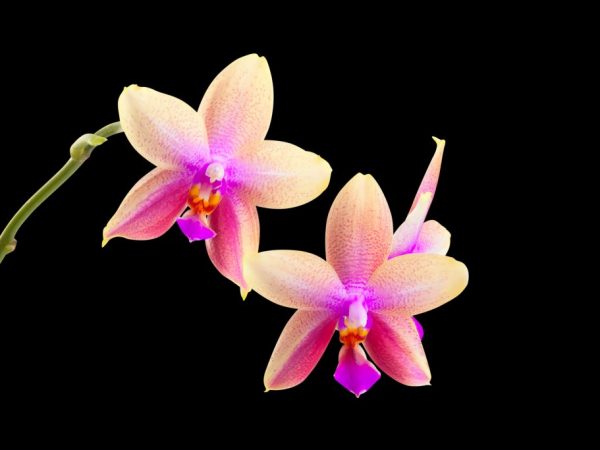Liodoro orchid and caring for it
Orchid is a beautiful and delicate flower that brings good mood and joy with its exotic look. The Liodoro Orchid is an unusual specimen and will become the highlight of any flower garden.

Liodoro Orchid
Description of the variety
Phalaenopsis Liodoro is a recently bred hybrid. The color can be different: from yellow to deep pink, and sometimes almost crimson, with a good aroma reminiscent of lily of the valley with hints of lime.
A feature of this species is flowering in batches, about 5 flowers per period. Leaves are light green in color, with a delicate structure. The stem reaches 50 cm in length.
Growing
The Liodoro stem, when grown at home, requires certain care rules.
Landing
Phalaenopsis Liodoro needs a lot of light.
The size of the planting pot should be about 1.5 - 2 liters in order to allow good drainage under the substrate.
There are differences in the technique of planting by seed or sprout.
Seed planting
You will need vessels that can be sterilized and closed with a lid.
To prepare the solution, take 150-200 g of distilled water and pour it into agar-agar. After it swells, it is placed on a steam bath and brought to dissolve the agar. Then add glucose or table sugar (1: 1). Dilute the mixture with 1 liter of water and bring to a boil.
The acidity of the environment at home is measured by special litmus indicators. A pH level of 4.8 - 5.2 is ideal for seeds.
Before sowing, the seeds are disinfected with a bleach solution for 5 to 10 minutes. Then placed in a sterilized container with the prepared solution and substrate. At a temperature of 18-23 ° C, the sprouts will appear within 7-30 days. When the sprouts are finally strong, transfer to a non-sterile environment (this takes about a year).
To prepare a non-sterile substrate, you will need:
- sphagnum moss;
- pine bark:
- drainage layer.
Broken bricks, polystyrene foam, large pieces of bark are suitable for the drainage layer. The flower sprout is treated with a foundationol solution and placed in a pre-steamed substrate.
Sprouting
The sprouting technology is much easier for home growing. Phalaenopsis liodoro babies are sold in small pots with a special moss substrate - they are already well rooted and ready to be transplanted into a larger pot for permanent residence.
For this you will need:
- basket or pot;
- substrate;
- drainage layer.
The container is filled with a layer of brick or large bark, partially filled with a substrate from above. The young plant is laid on the soil with roots, and then carefully sprinkled with the rest of the substrate.
Use transparent pots to monitor the condition of the flower's roots.
Care
After transplanting to a permanent place, Phalaenopsis liodoro requires proper care. It includes:
- fertilizer;
- pruning;
- watering;
- temperature and lighting.
The main part of the fertilizer is applied during the period of rapid growth, when the plant requires more minerals.For this, special solutions are used, sold in flower shops. Feed once a week.
Phalaenopsis Liodoro does not require abundant watering, because the substrate with moss retains moisture well. To keep the roots from drying out and slightly moisten the roots, immerse the pot in warm water for a few seconds.
Dry parts are trimmed in time, dried leaves and buds are regularly removed to facilitate the growth of the orchid.
The flower does not tolerate sudden temperature changes, the optimal room temperature is from 19 to 21 ° C. The air should be slightly cooler at night.
Moisture level 50 - 60%. Household humidifiers do an excellent job of controlling indoor air humidity.

Liodoro Orchid Care
Diseases and pests
Even at home, flowers are not immune to disease and pests. Deviations noticed in time can save the flower at an early stage of infection.
Fight disease
The main diseases are different types of rot, fungi and infections:
- anthracnose;
- powdery mildew;
- rot;
- rust.
Anthracnose appears on the leaves as spots that darken over time. Remove the affected leaves, and treat the cut sites with iodine. In the later stages, drugs such as Mikasan and Ritomil are used. A fungal disease called powdery mildew is common and occurs in rooms that are too warm and humid. It is treated with abundant watering, and after an hour it is treated with a solution of colloidal sulfur, or by means of "Skor" taking into account the description of the drug.
For all types of rot, the treatment is similar. The damaged area of tissue is removed, and the rest is sprayed with an antifungal agent. In severe cases, substrate replacement is required, especially with root lesions.
Pest control
There are several main pests that are dangerous to phalaenopsis:
- aphid;
- shield;
- nematode.
Aphids are small, inconspicuous beetles that feed on orchid leaves and release toxic substances. They are removed with soapy water, and the plant is washed with phytoverm solution.
Nematoda - worms, 1 - 2 mm in length, breaking through the channels in the leaves. Rinse the substrate with levimizil or decaris.
Scabbard - appears as a tubercle on stems or leaves. It is removed by washing with a brush and processing the whole flower and substrate with a phytoverm.
Prophylaxis
For prevention purposes, you should constantly monitor the orchid. If you suspect a fungus, treat with fungicidal agents. Change the substrate periodically.
Conclusion
Growing Phalaenopsis liodoro has a lot of difficulties, since the flower is fastidious and gentle, and requires special care. But not one florist can refuse such beauty and grace in his collection.


